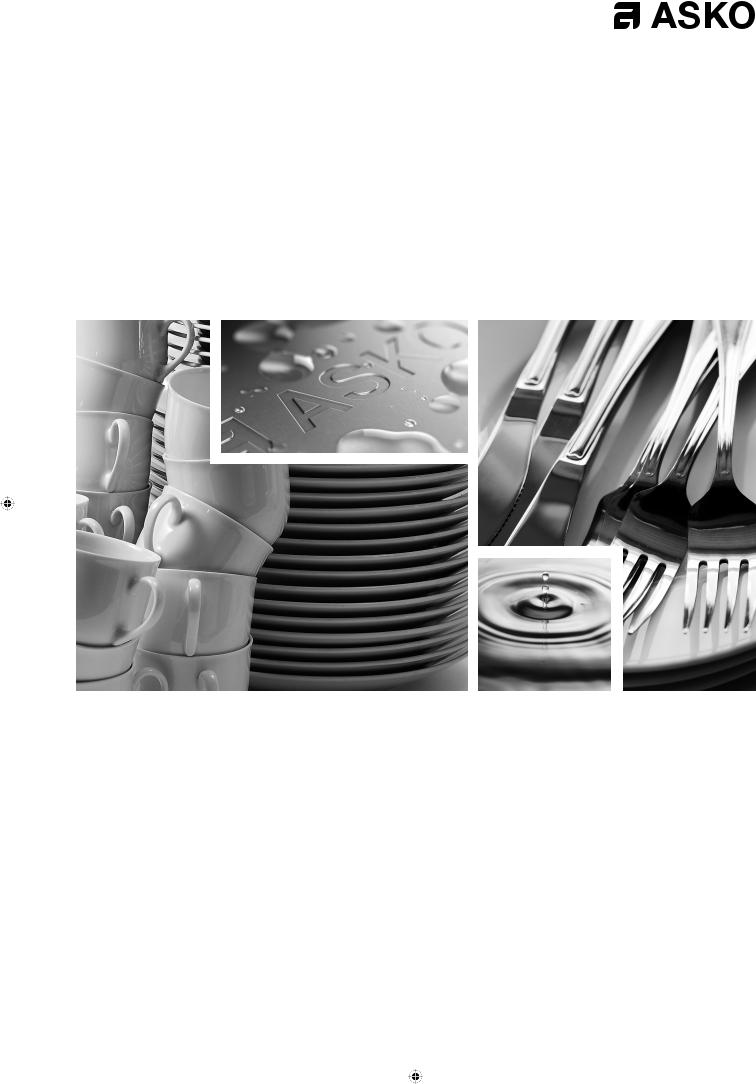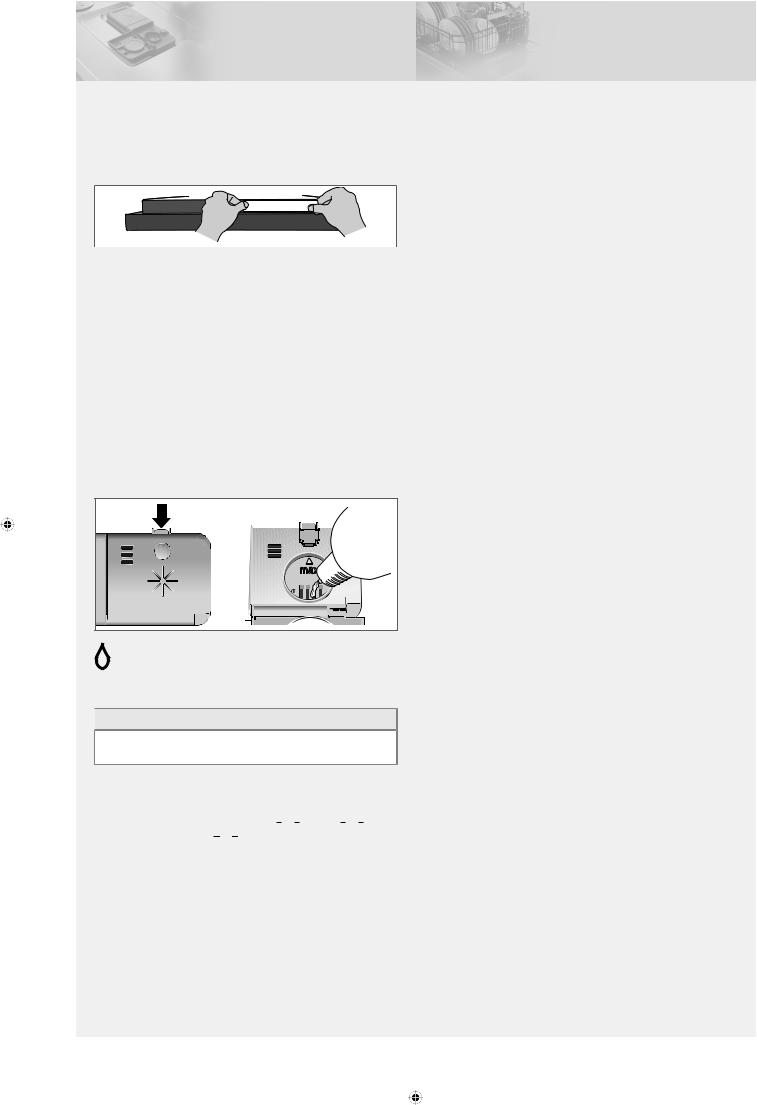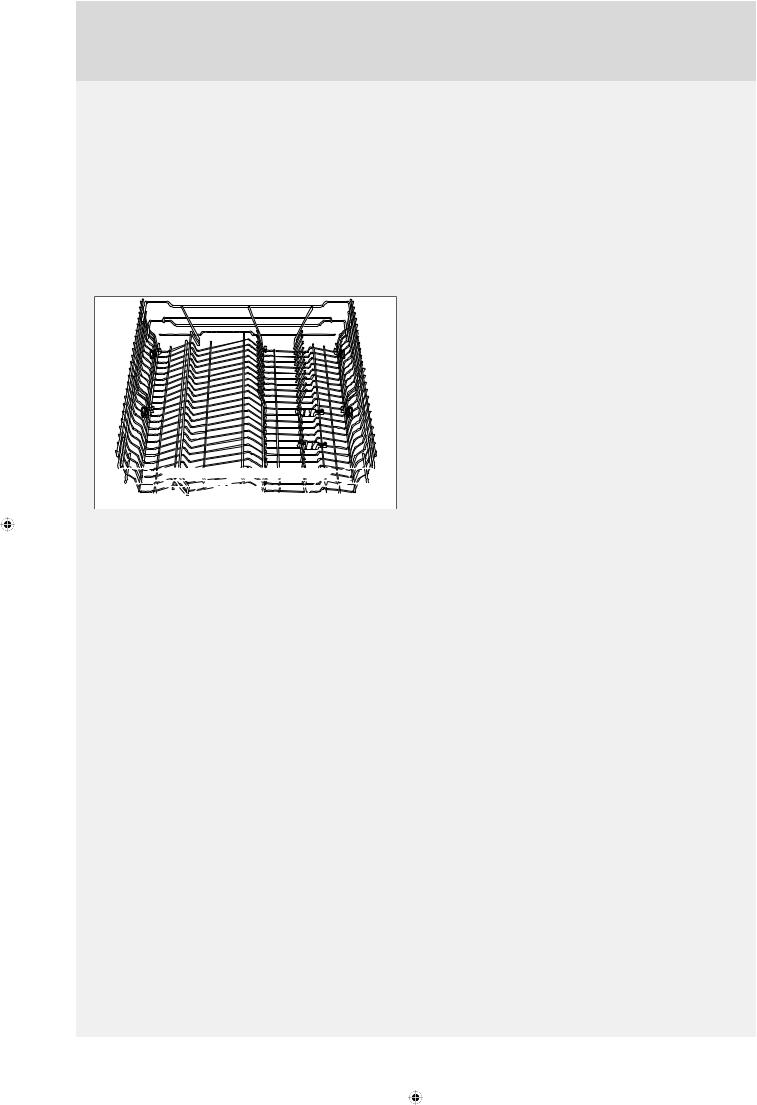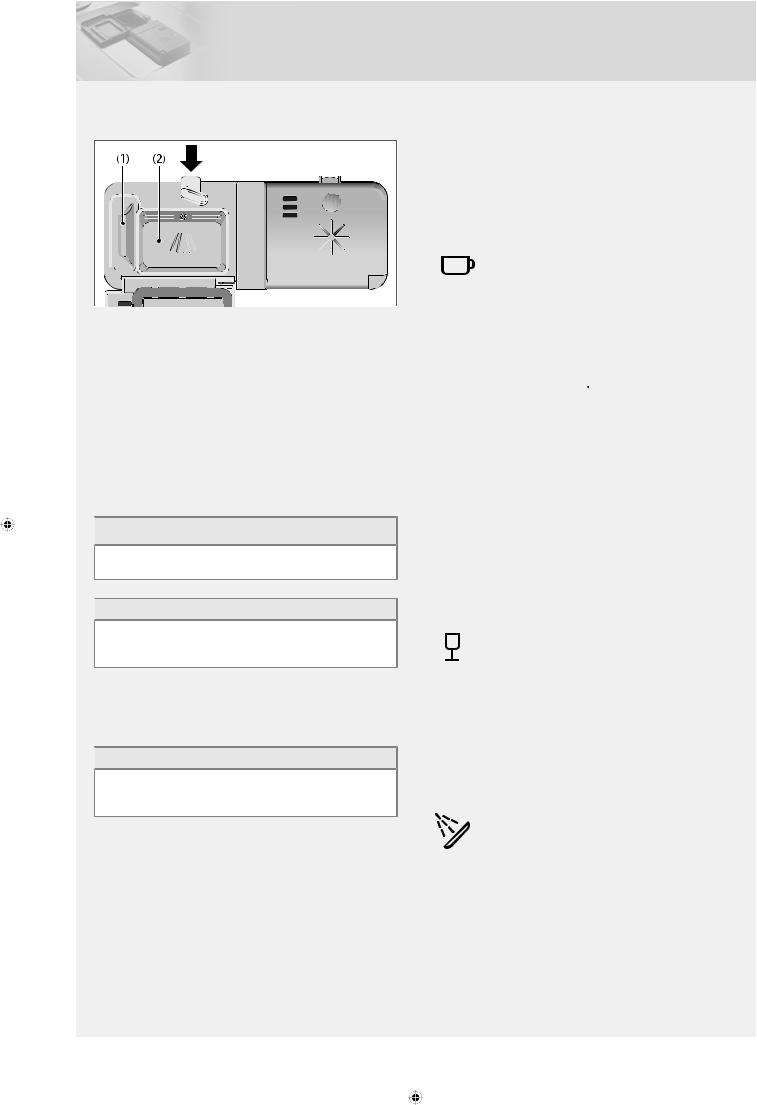Asko D5536 FI User Manual

Dear Customer,
Thank you for choosing this quality product from ASKO.
We hope it will meet your expectations and fulfil your needs for many years to come. Scandinavian design combines clean lines, everyday functionality and high quality. These are key characteristics of all our products and the reason they are greatly appreciated throughout the world.
To get the most from your new dishwasher, we recommend that you read the operating instructions before using the dishwasher. The operating instructions also include information on how you can help protect the environment.
Operating Instructions
Dishwasher
ASKO D5536 FI

Contents
Front panel |
2 |
Care and cleaning |
10 |
Safety instructions |
3 |
Troubleshooting |
12 |
Before washing for the first time |
4 |
Technical information |
15 |
Loading the dishwasher |
4 |
Installation |
17 |
Using the dishwasher |
6 |
ASKO Service |
18 |
Settings |
8 |
Program chart |
19 |
Front panel
|
|
|
|
|
|
|
|
|
|
|
|
|
|
|
|
|
|
|
|
|
|
|
|
|
|
|
|
|
|
|
|
|
|
|
|
|
|
|
|
|
|
|
|
|
|
|
|
|
|
|
|
|
|
|
|
|
|
|
|
|
|
|
|
|
|
|
|
|
|
|
|
|
|
|
|
|
|
|
|
|
|
|
|
|
|
|
|
|
|
|
|
|
|
|
|
|
|
|
|
|
|
|
|
|
|
|
|
|
|
|
|
|
|
|
|
1 |
2 |
3 |
4 |
5 |
6 |
7 |
8 |
9 |
|
10 |
|||||||||||
1 |
On/Left-on mode |
|
|
|
|
|
5 |
|
Rinse aid indicator |
|
|
9 |
Delayed start |
|||||||||
2 |
Program selector |
|
|
|
|
|
6 |
|
Child lock (button lock) |
|
|
10 |
Start/Stop |
|||||||||
3 |
Program symbol |
|
|
|
|
|
7 |
|
High temperature |
|
|
|
|
|
||||||||
4 |
Display |
|
|
|
|
|
|
|
8 |
|
Long dry |
|
|
|
|
|
|
|
||||
The panel is fitted with touch buttons with audible feedback (see the chapter Settings).
 NOTE!
NOTE!
•Two minutes after pressing any button, the control panel enters energy-saving mode. Close and reopen the door, or press the On/Left-on mode button, to reactivate the panel.
2

Safety instructions
General
•Read the operating instructions and keep them in a safe place!
•Never use the dishwasher for any purpose other than that specified in these operating instructions.
•Do not load the dishwasher door or dishwasher baskets with anything other than dishes.
•Never leave the dishwasher door open as someone may trip on it.
•Use only dishwasher detergent!
•This appliance is not intended for use by persons (including children) with reduced physical, sensory or mental capabilities, or lack of experience and knowledge, unless they have been given supervision or instruction concerning use of the appliance by a person responsible for their safety.
•Damaged mains cables must only be replaced by a qualified electrician.
•This dishwasher is for household or similar use, such as:
-staff kitchens in shops, offices and other workplaces.
-farms.
-for guests at hotels, motels and other types of accommodation.
-bed & breakfast hotels.
•Never place dishes with solvent residues in the dishwasher due to the risk of explosion. Nor may dishes that contain ash, wax or lubricants be washed in the dishwasher.

 WARNING!
WARNING!
Knives and other pointed items must be placed with the points down in the cutlery basket or horizontally in other baskets.
Installation
See the section Installation.
Child safety
•Always close the door and start the program immediately after you have added the detergent.
•Keep children away from the dishwasher when the door is open. Some detergent may remain inside!
•Do not allow children to use or play with the dishwasher. Be especially vigilant when the door is open.

 WARNING!
WARNING!
Dishwasher detergents are strongly alkaline. They can be extremely dangerous if swallowed. Avoid contact with skin and eyes and keep children away from the dishwasher when the door is open.
Check that the detergent compartment is empty after completion of the wash cycle.
Activate child lock (Kid Safe™)
You can activate the child lock (button lock) to prevent children from starting the dishwasher (see the section Settings).
Winter storage/Transport
•Store the dishwasher where the temperature remains above freezing.
•Avoid long transport distances in very cold weather.
•Transport the dishwasher upright or laying on its back.
Overflow guard function
The overflow protection starts pumping out the machine and turns off the water supply if the water level in the dishwasher exceeds the normal level. If the overflow protection is triggered, turn off the water supply and call the service department.
Cleaning
When cleaning the edge around the door, use only a slightly damp cloth. Do not spray water around the edge! Moisture can make its way into the lock, which contains electrical components.
Packing material
Sort waste materials in accordance with local guidelines.
Disposal
•When the dishwasher has reached the end of its service life and is to be disposed of, it should immediately be made unusable. Pull out the power cable and cut it as short as possible.
•The dishwasher is manufactured and labelled for recycling.
•Contact your local authority for information about where and how your dishwasher should be correctly recycled.
3

Before washing for the first time
Program key
Some dishwashers include program keys in different languages. Attach the program key in the desired language to the top of the door.
Checking water hardness
Contact the local water utility to check the water hardness in your area. This is important with regard to how much detergent and rinse aid to use.
Top up with rinse aid
By using rinse aid you will improve your drying result. You will also achieve a better dishwashing result with glassware and dishes.
1 Open the rinse aid compartment lid.
2Carefully top up with rinse aid. Only add rinse aid to the level marked max.
3 Wipe up any splashes of rinse aid around the compartment.
4 Close the lid firmly.
Refill rinse aid indicator
When the rinse aid needs topping up, the above symbol lights on the display.
 NOTE!
NOTE!
After topping up, it may take a while before the symbol goes out.
Setting the rinse aid dosage
The section Settings describes how to set the rinse aid dosage. Rinse aid dispensing can be set from 

 (Off) to
(Off) to 


 (High dose). (Factory settings:
(High dose). (Factory settings: 


 )
)
Increase the rinse aid dosage:
• If the dishes have water marks.
Decrease the rinse aid dosage:
•If the dishes have a sticky white/blue film.
•If the dishes are streaked.
•Build-up of foam. If you have very soft water, the rinse aid can be diluted 50:50 with water.
For water with a hardness greater than 10–12 °dH, you ought to use rinse aid with citric acid (known as acid rinse aid).
Loading the dishwasher
Economic dishwashing
Run programs only with a full load
Wait to run a program until the dishwasher is full. This way you save energy. Use the Rinse & Hold program to rinse the dishes if there are any unpleasant odours while you wait for the dishwasher to become fully loaded.
Run programs at a lower temperature
If the dishes are only slightly dirty, you can select a lower temperature with certain programs. See also the section Selecting Options in the chapter Using the dishwasher.
Select a program with the option Short dry
To save energy, use Short dry. The drying result will be better if, once the program is finished, you leave the door slightly open.
Do not rinse under running water
Simply scrape off large food particles before loading the dishwasher.
Choose a green detergent
Read the environmental declaration on the packaging!
Connect to cold water...
If you use oil or electricity to heat your home.
Connect to hot water (max. 70 °C)...
If you use district heating, solar power or geothermal power to heat your home. Choosing a hot water connection cuts program times and reduces the dishwasher's electricity consumption.
Fragile dishes
Some cookware is not dishwasher safe. This can be for several reasons. Some materials cannot withstand strong heat, others can be damaged by dishwashing detergent.
Fragile decoration
Porcelain with decoration on top of the glazing (the items feel rough) should not be washed in a dishwasher.
Crystal/Glass
Place items so that they do not touch each other during the wash. Use a short program with the lowest possible wash temperature. Select Short dry. Delicate and very fragile items should not be washed in a dishwasher.
Glassware washed in a dishwasher at high temperatures can gradually develop a grey film that cannot be removed. Wash fine glassware at a low temperature and with a small amount of detergent.
Silver
Silver and stainless steel items should not come into contact, as the silver can become discoloured.
Cutlery with glued handles
Some types of glue are not dishwasher safe. In such cases, the handles may loosen.
Wood
Wooden items should only be washed in a dishwasher if marked dishwasher safe.
Aluminium
Aluminium can lose its shine if washed in a dishwasher. However, good quality aluminium pans can be washed in a dishwasher, even if some of the shine will be lost.
Plastic items
Avoid washing plastic items that cannot withstand high temperatures.
4

The dishwasher's baskets
The dishwasher is equipped with an upper basket and a lower basket with cutlery basket.
The appearance of the baskets may differ depending on the dishwasher setup.
Upper basket
Place glasses, cups, bowls, side plates and saucers in the upper basket. All dirty surfaces should face inwards and downwards! Wine glasses are placed on the wine glass shelf and knives are placed in the knife stand on the right (if fitted).
Lower basket
Place plates, side plates, serving dishes, pots and cutlery (in the cutlery basket) in the lower basket.
Cutlery basket
Place cutlery with the handles facing down, except for knives, and spread them out as much as possible. Ensure that spoons do not stack inside each other.
The cutlery basket is placed in the lower basket.

 WARNING!
WARNING!
Knives and other pointed items must be placed with the points down in the cutlery basket or horizontally in other baskets.
Fold-down section for small items
The cutlery basket has a fold-down section in the middle for small items, or small shafts, such as electric whisk attachments.
A |
B |
C |
Cutlery basket with lid
A B C
Positioning of cutlery basket lid (in upper basket)
The cutlery basket lid can be removed and used, for example, as an extra cutlery basket in the upper basket (see below).
A B
NOTE!
Check that the spray arms can rotate freely.
5

Using the dishwasher
Add detergent
1 Prewash detergent compartment
2 Main wash detergent compartment
Detergent is added according to water hardness.
Follow the instructions on the detergent packaging.
Too much detergent can result in less effective dishwashing and also entails greater environmental impact.
Add the detergent to the detergent compartment. There is a compartment for the prewash and one for the main wash. If powder and liquid dishwasher detergents are used, add a small amount of the detergent to the prewash compartment. Contact the detergent manufacturer if you have any questions about the detergent.

 WARNING!
WARNING!
Children must be supervised – dishwasher detergent is corrosive!
 NOTE!
NOTE!
Use only dishwasher detergent! Washing up liquid must not be used as the foam that forms prevents the dishwasher from operating effectively.
Dishwasher tablets
Halve the tablet if it is difficult to close the dispenser lid. There is a risk that the detergent will not be released properly if the lid is tight and will not open correctly.
 NOTE!
NOTE!
Dishwasher tablets are not recommended for short programs (less than 75 minutes). Use powder or liquid dishwasher detergent instead.
3–in–1/All-in-one detergent
Read through the directions for these products carefully. If anything is unclear, contact the detergent manufacturer.
 On/Left-on mode
On/Left-on mode
Press and hold the On/Left-on mode button until the display lights up.
Program selection
Press the Program selector one or more times until the desired program symbol appears on the display.
 Heavy
Heavy
Program for very dirty dishes, such as pans, casserole dishes and oven dishes. If these dishes do not completely fill the dishwasher, you can add plates and the like.
 Normal
Normal
Use to wash normally soiled load, such as plates, serving dishes, cups, glasses and so on.
For washing normally soiled mixed loads, with the best energy and water performance, use the Normal; low temperature, short drying (no options).
If you want to improve the dishwashing and drying result activate
the options high temperature  and long drying
and long drying . This causes a slight increase in energy consumption.
. This causes a slight increase in energy consumption.

 Daily
Daily
A program suitable for day-to-day dishwashing. This program can also clean dried leftovers, but is not intended for burnt food, such as on oven dishes.
 Quick
Quick
This program is used for glasses and porcelain that is slightly dirty, such as coffee cups.
HygHygiene
This program is designed to meet strict hygiene demands.
 Delicate
Delicate
If the dishes are not very dirty, you can select Delicate. This program is intended for glasses and porcelain that have just been used and as such do not require such a powerful program.
This program can be used for delicate dishes. Select Short dry if you want to be especially cautious. See also the section Fragile dishes in Chapter Loading the dishwasher.

 Eco
Eco
Use when you want to save water. For normally dirty dishes.
Rinse & Hold
Used to rinse dishes while you wait for the dishwasher to become fully loaded.
Selecting Options
To select an option, press one of the option buttons. The field under the button lights when the option is activated. The available options depend on the selected program. Once you have started the program, the options you selected are saved for the next time
6
